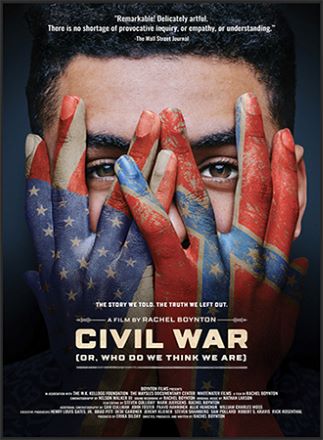
Civil War (or, Who Do We Think We Are) 2021
Distributed by Outcast Films, 511 6th Avenue Suite 398, New York, NY 10011
Produced by Rachel Boynton, Erika Dilday, and Thea Piltzecker
Directed by Rachel Boynton
Streaming, 100 mins
High School - General Adult
African American History; Race Relations; U.S. History
Date Entered: 05/31/2022
Reviewed by Russell A. Hall, Reference and Instruction Librarian, Penn State ErieCivil War (or, Who Do We Think We Are) is a documentary film that explores the stories that emerged in the wake of the American Civil War and how the reverberations of those stories are still felt today. As Rachel Boynton, the filmmaker, states at the beginning of the movie, “We told ourselves a story to make peace and for a long time we had trouble telling the difference between that story and the truth.”
Civil War is structured into six chapters and framed by segments of a lecture by renowned Yale professor David Blight. The bulk of the film consists of expertly conducted interviews of residents, politicians, school-age children, college students, teachers, and professors. These interviewees hail from Mississippi, Massachusetts, and Tennessee. The interviews center on themes that emanate from the Lost Cause myth/story created by white southerners during the Reconstruction period. As explained by the film, white southerners had lost their entire way of life, as well as 18% of their white, male population. Life as they knew it was gone (but remember it took the enslavement of millions of Black people to create the lifestyle of the Old South). These white southerners needed some way to make sense of this upheaval and a means to assuage the fear that came with having an uncertain social order. They found an answer in the Lost Cause narrative, a myth that glorifies Confederate soldiers, romanticizes the plantation life of the antebellum south, and most importantly, removes slavery (and its attendant horrors) as the cause of the Civil War. Further, the Lost Cause myth serves to crush Black memory, with one example being the arguments over Confederate symbols and monuments that we see today. The film adroitly explains how whites in the North were complicit in the Lost Cause narrative by using it to reunify the nation after Reconstruction. The Lost Cause allowed whites to focus on the battlefield valor of both sides during the war, while decentering the importance and the horrors of slavery. The film does an excellent job of showing how talk of slavery is suppressed but the valor of Confederate soldiers is widely discussed and seems central to the identity of many white Southerners. Through the lens of the false story of the Lost Cause, Civil War demonstrates the power of stories to shape societies and even oppress groups within societies.
There is one flaw in this otherwise excellent film. Toward the end, filmmaker Boynton states that “I’ve really come to believe that part of the purpose of history is to tell a story that unites us.” This statement contradicts and undermines the main theme of the film. Civil War shows how misusing history to create unifying myths can be incredibly damaging. The Lost Cause was a unifying myth for the South that later became a unifying myth for the United States. The cost of that unifying myth has and is intolerably high. The Lost Cause suppressed Black Americans and has not allowed a national reckoning over slavery and white supremacy. The film does a tremendous job of showing the dangers of historical mythmaking and it is disappointing that Rachel Boynton would allow her contradictory statement into the final edit. Despite this fault, Civil War (or, Who Do We Think We Are) is a superb film that would be useful in a wide range of courses and subject areas.
Published and licensed under the Creative Commons Attribution 4.0 license. Anyone can use these reviews, so long as they comply with the terms of the license.